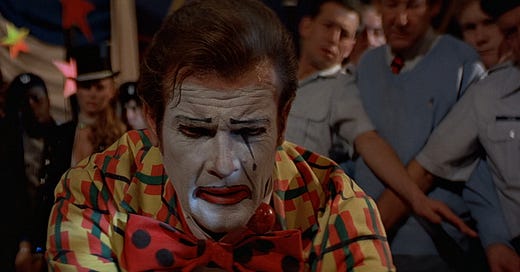James Bond Declassified: OCTOPUSSY
Roger Moore returns... but is that a good thing?
File #13: OCTOPUSSY
This series will trace the cinema history of James Bond, while also examining Ian Fleming's original novels as source material and examining how faithful (or not) the films have been to his work.
Directed by John Glen
Screenplay by George MacDonald Fraser and Richard Maibaum & Michael G. Wilson
CHARACTERS / CAST
James Bond / Roger Moore
Octopussy / Maud Adams
Kamal Khan / Louis Jordan
General Orlov / Steven Berkoff
Magda / Kristina Wayborn
Gobinda / Kabir Bedi
Vijay / Vijay Amritaj
Mischka and Grischka / David Meyer and Anthony Meyer
Jim Fanning / Douglas Wilmer
General Gogol / Walter Gotell
M / Robert Brown
Q / Desmond Llewelyn
Miss Moneypenny / Lois Maxwell
Penelope Smallbone / Michaela Clavell
CREDITS SEQUENCE
If Octopussy is your favorite Bond film, then (A) you may not want to read this installment of James Bond Declassified and (B) what the hell is wrong with you?
United Artists was on the ropes after the making of Heaven’s Gate, although it’s unfair to claim that movie is the only reason they were struggling. Then, as now, James Bond was one of the few genuine assets the studio had going for it, and they were already developing a new Bond film when MGM purchased the studio. George MacDonald Fraser was the first writer in, and it was his task to stitch together pieces of several short stories from Ian Fleming’s final collection. Fraser’s draft established he settling for much of the film as India, but pretty much as soon as he turned in a pass, Michael Wilson and Richard Maibaum were put to work making sure this felt like a Bond movie. After all, they were fresh off of For Your Eyes Only with the same filmmaker.
Speaking of For Your Eyes Only, that film created a bit of a problem for them. Remember the opening sequence where they were very careful not to identify Blofeld as Blofeld before they killed him? That was a pretty direct “fuck you” to Kevin McClory, who had been battling the Broccolis for decades over the rights to material he co-created with Ian Fleming for a screenplay that Fleming eventually repurposed into the novel Thunderball. While I know it was a headache for EON over the years, McClory was right. He deserved co-ownership, at least for that one story, and I would argue that the work he did with Fleming helped set the template that the filmmakers used for decades and their continued battle with McClory was genuinely wrong.
Finally, as the ‘80s were getting started, McClory finally had a way to tell the Broccolis “fuck you” right back. Even if United Artists didn’t want to make a Bond movie in 1982/1983, they had no choice, since McClory had finally cleared the legal path for him to make the film that had gone through several titles by that point, including Warhead and James Bond of the Secret Service, and McClory had scored a huge coup by securing Sean Connery to return to the role. By this point, Roger Moore was tired and had no intention of returning, leading the producers to scramble to try to find a replacement. They screen-tested actors like Timothy Dalton, Oliver Tobias, and James Brolin, but they realized that the idea of putting a brand-new actor in the role up against the iconic first star of the series in a head-to-head battle might not have the outcome they hoped for, and they basically begged Moore to play the part again even though his contract had expired. They were already shooting the film when Moore finally agreed to don the tuxedo and pick up his license to kill one more time.
Roger Moore looks significantly older the first time we see him here.
Keep reading with a 7-day free trial
Subscribe to Formerly Dangerous to keep reading this post and get 7 days of free access to the full post archives.



